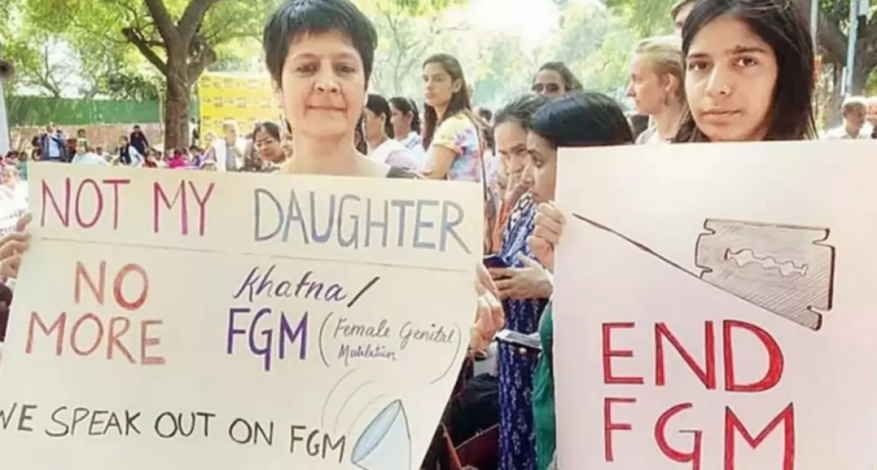Female Genital Mutilation- Continuing fight Against Patriarchy, Religion and Politics. Conversation with Masooma Ranalvi

Our guest today is Masooma Ranalvi, founder of the organization We Speak Out, that works mainly on issues of female gential mutilation. She is in conversation with Suchitra Dalvie, Coordinator ASAP.
Suchitra-Welcome to this next episode of ASAP conversations. The Asia Safe Abortion Partnership has been reaching out to its members, partners and other key stakeholders across the region and through various constituencies and communities, in order to create a sense of solidarity and to recognize the universality of the issues we are all facing under the current global pandemic.
Also, to ensure that certain voices which are either underrepresented or completely missing from global political discourse are recognized and heard. So, I am pleased to have with us here today Masooma, whose been very active in the work around female genital mutilation.
Masooma- Thank you so much Suchitra, pleasure to be here in this virtual meeting. Primarily the issue of female genital mutilation hasn’t got any recognition in India, although it has been practised here for centuries. There is no political acceptance of the practice because socially people outside the community do not really know that something like this exists since it’s a silent practice and it’s a sacred practice. So, the work I do is within the community as well as outside, with the government as well as with the legal system and to bring to the fore this issue and to find ways and means to eliminate the practice in India.
Suchitra- Thank you for explaining that. It is really a very challenging work that you have undertaken. Could you elaborate a little bit for our audience who doesn’t know exactly what a female genital mutilation involves? There is a lot of conversation which says it should actually be called circumcision and it’s kind of a political labeling to call it mutilation.
Masooma- Sure, so currently at this point in history the world refers to this practice as female genital mutilation (FGM). It’s not a practice which is confined to India. It exists in the whole of Africa, it exists in continents of South America, Australia Asia, Europe– so pretty much in every part of the world and uniformly it’s termed as female genital mutilation.
The issue of terminology is a very important issue. So in different communities it’s known by different names like for instance in my community, which is the Bohra community, it is known as khabz and in English it’s called circumcision. In Indonesia where the practice exists it’s known as khitna. In different parts of the Arab world in Africa there are different terms which are used for practice. To kind of give it a unified name the World Health Organization came out with this term ‘female genital mutilation’ or FGM 20 years ago.
Earlier it was referred to as circumcision. The problem with use of the word circumcision was, it was confused with male circumcision which is very different , so to make it a very distinct and separate issue the word female genital mutilation came into being. But still there is a lot of haggling. So you may call it whatever you want to call it circumcision, khabz, etc.
The point is that it is the nature of the practice that we are concerned about. There is a very comprehensive definition by the WHO which very clearly says that any alteration of the genital parts of a girl child for non-medical reasons is female genital mutilation.
Furthermore, the definition talks about the various types of FGM. One is the mildest form because it’s the cutting of the tip of the clitoral hood of the girl. Two involves the cutting of the labia minora and majora as well. Type three involves cutting all the external genitalia and sewing up the vaginal opening except for a part which remains open which is for urinating. Type four is any kind of insertion, nick, prick of the genital parts of the child.
The practise in my community is type 1 which is the cutting of the clitoral hood of the girl child. If anyone has any idea of the female anatomy and the female genital Anatomy, the clitoris itself is a very tiny part and the clitoral hood is even tinier. The manner in which this part gets cut in India is either through a midwife or sometimes through a medical practitioner. It’s done with the blade or a knife and the way in which it is done, inevitably, in nine out of ten cases along with the clitoral hood a part of the clitoris gets cut.
The clitoris is the only part in the female anatomy which is for sexual pleasure, so it is an extremely sensitive part– there are some seven thousand nerve endings on there. The clitoral hood is to protect the clitoris because it is such a super sensitive part—it’s like we have an eyelid to protect the eye. So by cutting the clitoral hood you’re exposing these very sensitive nerve endings of the clitoris to exposure and a lot of pain and physical and sexual problems for women.
Suchitra- This is a horrifying description of what women and girls have been suffering. What is the justification or the rationale behind this?
Masooma- The rationale across the board, across countries, is primarily to curb sexual desire in the girl. And the reason being that when a girl grows to a woman she should not experience sexual pleasure, or have premarital sex or extramarital affairs. So basically, it’s a patriarchal form of control of a woman and her sexuality. So that she’s preserved and protected for this man who is going to be her husband.
Suchitra- The work that ASAP has been doing around safe abortion rights advocacy and locating it within the gender and rights paradigm is actually just one end of the spectrum because here FGM is trying to prevent the girl from feeling any sexual pleasure and the patriarchal systems which reduce access to safe abortion are trying to control her sexuality at the other end.
If there isn’t enough of a fear of this unwanted pregnancy which is then going to result in social punishment, then how are you going to control women’s sexuality?! So, it’s really incredible and shocking how scared a certain system is of women’s sexuality– whether it is in terms of pleasure or in terms of consent, or being able to have a partner.
What do you think causes this fear of women’s sexuality? What is it that our cultures or the patriarchy is really afraid of?
Masooma- What you say is so totally true because ultimately along with sexual pleasure they are also controlling her rights to reproduction and to ensure that the child she conceives will only be that of her husband.
The whole control of her reproductive function and sexual pleasure which is kind of merged together somewhere along the line and the origins of FGM is literally thousands of years.
In fact, the practice predates Islam and Christianity and it existed in tribal Arab and Africa and it was a way in which feudal communities, you could control a woman. So, like in medieval Europe you had chastity belts to control a woman, here you actually had a physical way of doing it by actually just attacking her clitoris.
Suchitra- I am a practicing gynaecologist and I worked in the University College London for a few years during which time we saw a lot of refugee women from Sudan who used to have FGM done of a far more severe degree than the one you are describing. Their labia were almost completely shut and I remember the first time I encountered this woman who said it takes her about half an hour just to pass urine because there was such a small opening. And she was menstruating for pretty much half the month because it just took that much time for the blood to come out. It was absolutely unbelievable that someone could inflict this kind of trauma on someone particularly when they are girls as young as five or eight years old.
I was then unpleasantly shocked to find that some Gynaecologists or doctors are actually involved in this practice and the explanation being given is that makes it kind of safer in some way rather than having a midwife using may be a rusted or used blade. So, what is your perception on this? Is the practice in our country being facilitated by medical professionals?
Masooma- This is a new trend in cities like Mumbai, Ahmedabad, Udaipur, Pune, Surat towards medicalising the practice. But the point is that fundamentally it doesn’t take away from the reason behind the practice. Whether you do it in a sanitized way or you do it with a blade or a knife with a midwife, the point is you are attacking the woman and her body, you are impacting her bodily integrity with the intention of curbing her sexual desires.
I think this whole theory of ‘let’s do it in a nice way’ doesn’t make any sense and there should be a ban to it. As you described about Sudanese women, the type 3 which is called Infibulation, is the worst form and which often causes death also. Even for that matter any type of FGM whether it is type 1234 there is something which is basically inhuman about it. It basically violates something so integral to us as humanity and our human rights that there is no place for this practice.
Suchitra- I absolutely agree with you, the purpose of my question was to ask whether advocacy
needs to be done even with the medical professionals because I myself have come across some Gynaecologists who not only do but also advertise hymenoplasty so you can ‘be a virgin again’.
They also do surgery for tightening of the vagina to increase male sexual pleasure. So, I was wondering who are all the key stakeholders that one needs to really work with. Maybe you talk a little bit about that as you said the practice which is happening in India or in your community is often of a less severe type but I’m sure there are still some psychosexual ramifications and a long-term impact of these practices on the girls as they grow up.
Masooma- Yeah, I will not really use the word less harmful as it is as harmful. Yes, I do agree that there are huge psychosexual implications to this and also you’re doing it for child there is absolutely no question of consent and it’s actually a form of child abuse.
Suchitra- And there is no health benefit.
Masooma- Right, and you are right that there are many doctors and gynaecologists who do perform this. In fact, one of the biggest cases in the world of FGM, (there are very few cases actually to report for FGM) is a case of America which involves a medical practitioner. Doctor Nagarwala was accused in a court in Detroit of performing this practice in a clinic out there to hundreds of girls. So, there is a need to act at multiple levels and work with medical bodies.
Suchitra- Could you tell us a little bit more about the work you’re doing through your organization? Who are the key stakeholders you’ve been working with? What kind of successes
you’ve had? What are the challenges?
Masooma- Primarily we work at two levels. One is at the level in the community. The nature of the practice is secret so very few people really know. Until we kind of came out in the public and said this is what happens to us, they really didn’t know that this is a rampant practice. The research which we’ve done shows that even now 75 to 80% girls in our community are cut.
So, it’s a huge statistic and it continues unabated in an extremely secretive manner because there is a huge amount of ignorance. It is a tradition which carries from grandmother to mother to daughter with literally very few people beyond that circuit knowing about it.
So, if you have a brother in the house, he might not know about it. Many times the fathers don’t know about it.
As a result of this secrecy people don’t understand the implications of this on the body of the child, psychosexually and later on when she becomes an adult how this is going to impact her life and her future. There is an increasing need for awareness within the community and this has to be done extremely sensitively.
That is one level of the work which we do literally in one-to-one conversations with men and women and young girls, basically trying to make them understand, so that they make an informed choice. I mean tomorrow if you have a seven-year-old or six-year-old girl you should think about the consequences instead of just going and doing it because your mother or mother-in-law is telling you to do it.
The other level of work involves working with legal advocacy because at this point in time we do not have a law which bans FGM. You have the IPC section about grievous hurt, with harmful objects such as knives. Then you have POCSO protection of children from sexual offences. This may not be sexual intent but causing harm to the genital parts of the child.
The point is that these laws exist and yet the practice has not stopped. In fact, it’s openly propagated at times. So there is a need for a law which clearly says that this is a criminal act and you have to stop it. That way at least the women who want to stop doing it have the backing of the law.
We had a case a few years back of a botched up cutting of a six-year-old child who bled through the night. The mother didn’t know what to do, she kept changing bed sheets. Finally she called the cutter who said put Soframycin but still the bleeding didn’t stop. Finally, the cutter got scared and she said take her to a doctor. The hospital saw a child bledding from the genitals and they immediately thought its rape and they said they’re not gonna admit the child. Then finally with a contact to a social worker this child was taken to another hospital where she was sewn up.
The kind of trauma this child has gone through is not going to be easy to deal with later.
So we need the support and the backing of the law. I’m not saying a law is gonna solve our problem I’m not saying a law is going to end FGM– but that backing of a law is needed to kind of take forward our advocacy work.
Suchitra—As you said, we have had legal intervention to bring about social change for example say the practice of sati or child marriages or even the practice of dowry. They have all needed laws as a backing to support those who want to be able to challenge these traditional practices.
So what do you see as the way forward in the work you’re doing? Are there any positives? Is the younger generation more receptive to this information?
Masooma- Definitely, I think that’s a huge positive. The young are more receptive, they understand and they’re willing to engage– they’re willing to question and challenge the practices.
At the same time I would like to say that we are fighting against three very big institutions– one is patriarchy, second is the political system which is right now not supporting us and we are fighting against religion because the whole practice which is actually a traditional practice has been giving the religious right.
Suchitra- You’re absolutely right– it’s kind of like the unholy trinity of our development work. When you dig in deeper into any of the work we are dealing with we always come up against these three as an intersectional problem. It is very challenging but we are really grateful that people like you are speaking out because this year our theme year is to speak truth to power.
So it’s important to recognize who has the power and I think besides these ‘big three’ you know the politics, the religion and patriarchy, I think it’s the young people who are going to be the next power.
Let us hope that the work you are doing and the work we are doing will be taken forward by the next generation and on that positive note I would like to conclude this interview and thank you very much for your time and thank you very much for doing this very important work.
This blog is part of a series of ASAP Conversations with members and partners to understand the impact of the pandemic on safe aborion access for their communities.






